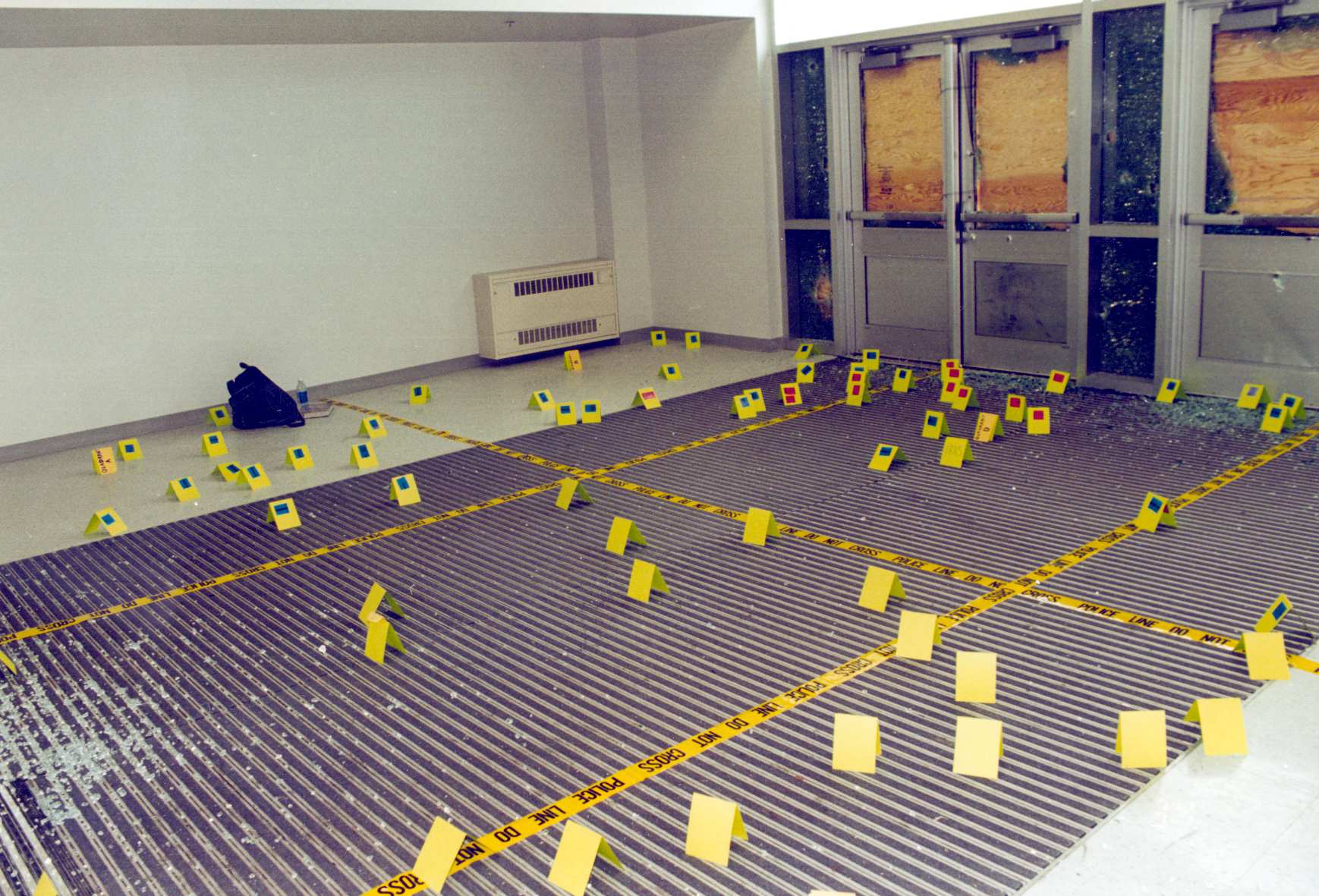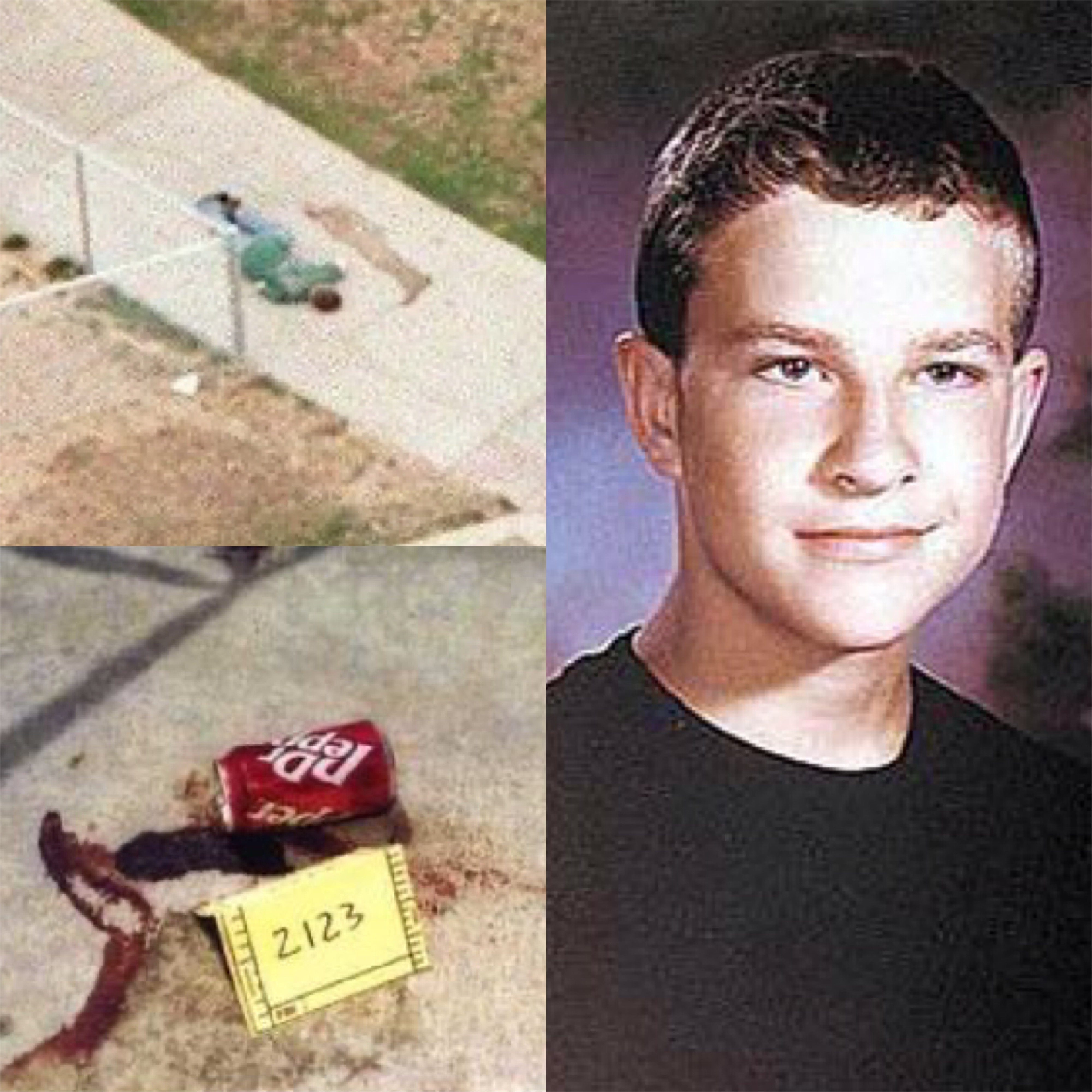Unveiling The Dark Truth: Crime Scene Photos Of Columbine Shooting
On April 20, 1999, the small town of Columbine was forever changed by a tragic event that shocked the nation. The crime scene photos of the Columbine shooting have become some of the most haunting images in modern history. These photos not only document a moment of unimaginable tragedy but also serve as a stark reminder of the impact of gun violence and the importance of mental health awareness.
As we dive into this topic, it’s important to approach these crime scene photos of Columbine with sensitivity and respect for those who lost their lives and the families who were forever changed. The images captured that day tell a story that goes beyond the headlines, offering a glimpse into the chaos and devastation that unfolded.
While some may argue that these photos should remain hidden to protect the victims' dignity, others believe they serve an essential purpose in educating the public about the realities of such tragedies. Let’s explore the significance of these crime scene photos and what they reveal about one of America’s darkest days.
Table of Contents
- The History of the Columbine Shooting
- Crime Scene Photos of Columbine Shooting
- The Impact of the Crime Scene Photos
- Media Coverage and Controversy
- Psychological Effects on Witnesses
- School Safety Measures Post-Columbine
- Key Statistics and Findings
- Ethical Considerations of Sharing Crime Scene Photos
- Lessons Learned from the Columbine Tragedy
- The Future of Gun Violence Prevention
The History of the Columbine Shooting
The Columbine High School massacre took place on April 20, 1999, when two students, Eric Harris and Dylan Klebold, carried out a deadly attack on their school. The tragic event left 13 people dead and 24 others injured, making it one of the deadliest school shootings in U.S. history. The planning and execution of the attack were meticulously documented by the perpetrators, adding another layer of complexity to the tragedy.
Law enforcement agencies responded swiftly, but the chaos and confusion at the scene made it difficult to contain the situation. The crime scene photos of Columbine shooting were taken during the investigation and provide a detailed account of the aftermath. These images have been studied extensively by experts to understand the psychological state of the attackers and the vulnerabilities in school security systems.
Key Events Leading Up to the Shooting
Before the attack, Harris and Klebold had spent months planning their assault. They created homemade bombs, gathered weapons, and even filmed themselves discussing their plans. These preparations were later discovered during the investigation, shedding light on the mindset of the perpetrators. The crime scene photos of Columbine shooting reveal the devastation caused by their actions and the impact on the school environment.
- Months of meticulous planning by the attackers
- Use of homemade bombs and firearms
- Filming of their intentions and preparations
Crime Scene Photos of Columbine Shooting
The crime scene photos of Columbine shooting are a powerful and often controversial aspect of the investigation. These images capture the immediate aftermath of the tragedy, showing the devastation inside the school and the emotional toll on first responders and victims' families. While some argue that these photos should remain private to protect the dignity of the victims, others believe they are crucial for understanding the full scope of the tragedy.
These photos have been used in various contexts, from law enforcement training to psychological studies. They provide valuable insights into the events that unfolded that day and the challenges faced by emergency responders. However, the decision to share these images publicly has sparked intense debate about the ethical implications of doing so.
What Do the Photos Reveal?
The crime scene photos of Columbine shooting reveal several key details about the attack:
- The layout of the school and the areas most affected by the violence
- The positions of victims and perpetrators at the time of the attack
- The extent of the damage caused by the homemade bombs
These images serve as a visual record of the tragedy, helping investigators piece together the sequence of events and identify potential areas for improvement in school safety protocols.
The Impact of the Crime Scene Photos
The impact of the crime scene photos of Columbine shooting extends far beyond the immediate investigation. These images have played a significant role in shaping public perception of the tragedy and influencing policy changes related to gun control and mental health. By providing a visual representation of the devastation, these photos have helped raise awareness about the dangers of gun violence and the importance of addressing mental health issues in schools.
However, the emotional toll of viewing these images cannot be underestimated. Many who have seen the crime scene photos of Columbine shooting report feeling a deep sense of sadness and anger, highlighting the need for responsible handling of such sensitive materials.
Emotional Reactions to the Photos
For those who have viewed the crime scene photos of Columbine shooting, the emotional impact can be overwhelming. Some common reactions include:
- Feelings of grief and sorrow for the victims and their families
- Anger towards the perpetrators and the systems that failed to prevent the attack
- Concern about the prevalence of gun violence in schools
Media Coverage and Controversy
The media coverage of the Columbine shooting was extensive, with crime scene photos playing a central role in the narrative. While some outlets chose to publish these images, others opted to focus on the broader implications of the tragedy. This decision sparked a heated debate about the ethical responsibilities of journalists and the potential consequences of sharing such graphic content.
Despite the controversy, the crime scene photos of Columbine shooting have become an integral part of the story, providing context and depth to the coverage. They have also raised important questions about the role of the media in shaping public opinion and influencing policy decisions.
Challenges Faced by Journalists
Journalists covering the Columbine shooting faced numerous challenges, including:
- Deciding whether to publish graphic images of the crime scene
- Navigating the ethical implications of sharing sensitive materials
- Balancing the need for accurate reporting with the potential for causing harm
Psychological Effects on Witnesses
The psychological effects of witnessing the crime scene photos of Columbine shooting can be profound. For those who were directly involved in the tragedy, including survivors, first responders, and family members of the victims, the images can serve as a constant reminder of the trauma they experienced. This can lead to long-term mental health issues, such as post-traumatic stress disorder (PTSD) and anxiety.
Studies have shown that exposure to graphic images of violence can also affect individuals who were not directly involved in the event. This highlights the importance of providing support and resources for those who may be affected by the crime scene photos of Columbine shooting.
Support for Those Affected
Various organizations and support groups have been established to help those affected by the Columbine shooting. These resources include:
- Counseling services for survivors and family members
- Training programs for first responders dealing with traumatic events
- Community initiatives to promote mental health awareness
School Safety Measures Post-Columbine
In the wake of the Columbine shooting, schools across the country have implemented new safety measures aimed at preventing similar tragedies. These measures include increased security protocols, mental health support for students, and active shooter drills. While these steps have helped improve school safety, the crime scene photos of Columbine shooting continue to serve as a powerful reminder of the work that still needs to be done.
Experts emphasize the importance of addressing the root causes of school violence, including bullying, mental health issues, and access to firearms. By focusing on prevention and early intervention, schools can create safer environments for students and staff.
Key Safety Measures Implemented
Some of the key safety measures implemented post-Columbine include:
- Installation of security cameras and metal detectors
- Training for teachers and staff on recognizing warning signs
- Development of emergency response plans
Key Statistics and Findings
Research into the Columbine shooting has revealed several key statistics and findings that highlight the broader implications of the tragedy. For example, studies have shown that:
- Approximately 20% of high school students report feeling unsafe at school
- Mental health issues are a significant factor in many school shootings
- Access to firearms increases the likelihood of violence
These findings underscore the importance of addressing the underlying causes of school violence and implementing effective prevention strategies.
Ethical Considerations of Sharing Crime Scene Photos
Sharing crime scene photos of Columbine shooting raises important ethical considerations. While these images can provide valuable insights into the tragedy, they also have the potential to cause harm to those who view them. It is essential to weigh the benefits of sharing these photos against the potential risks and ensure that they are used responsibly and with respect for the victims and their families.
Experts recommend that crime scene photos be shared only in specific contexts, such as law enforcement training or psychological research, where their use can contribute to a greater understanding of the tragedy and help prevent future incidents.
Guidelines for Responsible Sharing
To ensure the responsible sharing of crime scene photos, the following guidelines should be followed:
- Obtain permission from the victims' families before sharing images
- Use the photos only in educational or research contexts
- Provide warnings and support resources for those viewing the images
Lessons Learned from the Columbine Tragedy
The Columbine shooting taught us valuable lessons about the importance of mental health awareness, gun control, and school safety. By studying the crime scene photos of Columbine shooting and the events surrounding the tragedy, we can better understand the factors that contributed to the attack and work towards preventing similar incidents in the future.
These lessons emphasize the need for a comprehensive approach to addressing school violence, including increased funding for mental health services, stricter gun control laws, and improved communication between students, teachers, and parents.
The Future of Gun Violence Prevention
As we look to the future, it is crucial to continue the conversation about gun violence prevention and the role of crime scene photos of Columbine shooting in shaping public policy. By learning from past tragedies and implementing effective prevention strategies, we can create safer communities for everyone.
The legacy of the Columbine shooting serves as a powerful reminder of the importance of addressing the root causes of violence and working together to create a brighter future. By focusing on prevention, education, and support, we can honor the memory of those lost and ensure that such tragedies are never repeated.
Kesimpulan
Crime scene photos of Columbine shooting offer a powerful and often controversial perspective on one of America’s darkest days. While these images provide valuable insights into the tragedy, they also raise important questions about the ethical implications of sharing such sensitive materials. As we continue to grapple with the legacy of the Columbine shooting, it is essential to approach these photos with sensitivity and respect for the victims and their families.
By learning from the lessons of the past and implementing effective prevention strategies, we can work towards a future where such tragedies are a thing of the past. We invite you to share your thoughts and experiences in the comments below and join the conversation about gun violence prevention and mental health awareness.

SCENE_TEXT

The Columbine High School Massacre Crime Scene Cleanup

PHOTOS The massacre at Columbine High School and the days that followed